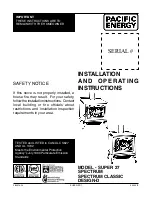
o
OPERATING ERROR: Ensure that all joints are in a good state of repair.
Replace any frayed or compressed joints. Do not light the stove with the front,
side or cinder door open.
Controlling the temperature is the best way of determining whether the stove has an
excessive fire. If you think your stove has an excessive fire, contact your supplier
immediately. Damage produced by excessive fire is not covered by the guarantee. The
results of an excessive fire may include: deformities or burning of internal parts,
decolouring and deformities on external parts and damage to the enamel.
N.B.: ANY SYMPTOM OF EXCESSIVE FIRE MAY ANNUL YOUR GUARANTEE!!
4.- MAINTENANCE
The temperature of the stove may be controlled using a special thermometer for
stoves, located in the centre of the worktop.
A.- PREVENTIONS AGAINST CREOSOTE AND ITS CLEANING.
To prevent the formation of creosote:
1. Keep the stove with the primary air control fully open for 30 minutes every day to
burn the creosote deposited inside the stove and the evacuation system.
2. After reloading the wood, keep burning with the primary air control fully open for
20 or 30 minutes. This form of operating ensures in advance the correct working order of
the secondary combustion that, when working, minimises the formation of creosote in the
chimney.
The chimney connector tube must be inspected at least every month during the
season of use of the stove to determine whether creosote has formed. If the creosote
residue has an accumulated thickness of 6mm., it must be removed to reduce the risk of
fire.
If the glass gets dirty often, the combustion temperature level is low, which implies
the risk of creosote forming.
The smoke evacuation system must be inspected at its connection with the stove
and at the top of the chimney. Cold surfaces tend to create deposits quickly and it is
therefore important to inspect the chimney at the top, as it is the coldest point: the opposite
to the connection with the stove.
The accumulated creosote must be removed using a special cleaning brush designed
for this purpose.
It is therefore recommendable to allow a professional to inspect the entire system,
clean it and repair it, where necessary, before each season of use.
B.- JOINTS
The joints must normally be changed every 2 or 3 seasons of use, depending on the
use of the stove. If the seal on the door is lost, a new joint ensures a suitable seal and
improves the working order of the stove. Contact your supplier for a set of joints for your
stove.
To replace the door joints, proceed as follows:
6. First remove the old joint using a tool or the tip of a knife.
7. Clean all of the joint channels with a wire brush to remove any remains of cement
and fibre.
8. Apply joint cement to the channels








































